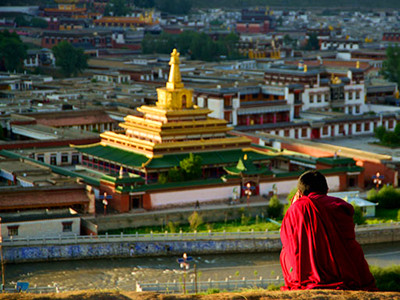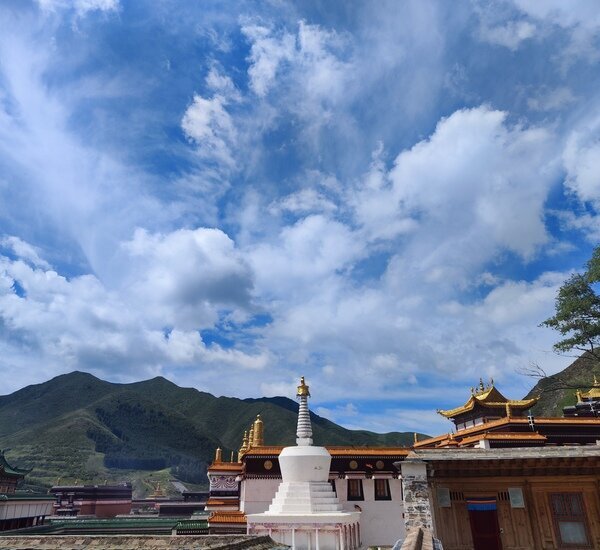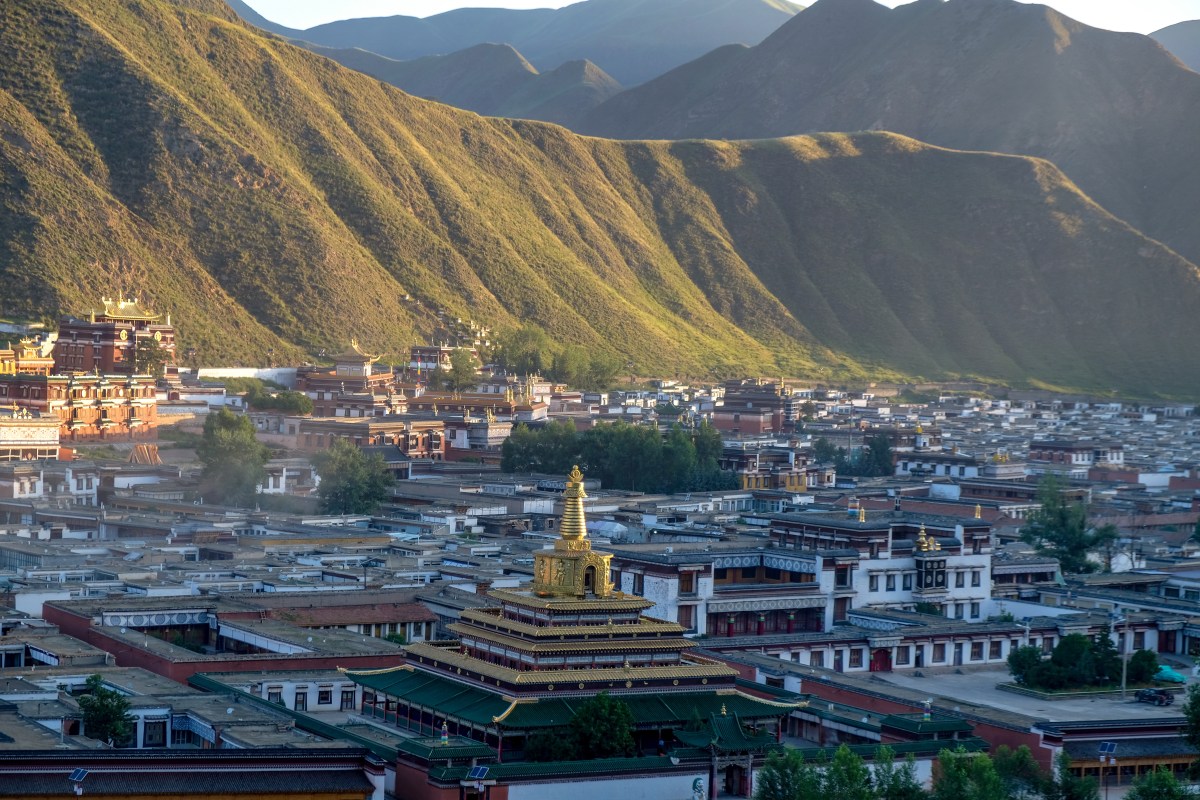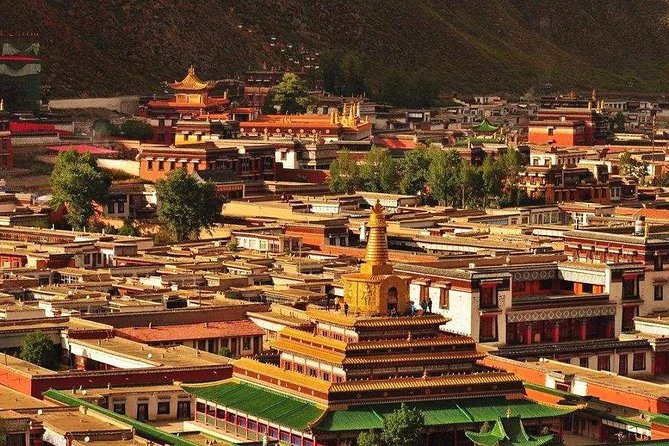Unveiling the Mystique of Labrang Monastery: Tips for Travelers

An Essential Guide to Visiting Labrang Monastery
Nestled within the breathtaking landscapes of Xiahe County, Labrang Monastery stands as a testament to the rich spiritual heritage of Tibetan Buddhism. Regarded as one of the six great monasteries of the Gelukpa (Yellow Hat) Sect, this sprawling complex is home to over 2,000 monks and boasts an impressive collection of eighteen halls, six institutes of learning, and nearly 60,000 sacred sutras. Visitors are often captivated by the monastery’s vibrant atmosphere, where the air is filled with the rhythmic chants of monks and the scent of burning incense.
As you explore this sacred site, you’ll find yourself walking alongside devoted pilgrims on the kora, a 3.5-kilometer prayer wheel trail that encircles the monastery. This unique path not only offers a glimpse into the daily lives of the monks but also provides an opportunity for spiritual reflection and connection with the local culture. With its striking architecture, serene ambiance, and profound spiritual significance, Labrang Monastery is more than just a destination; it’s an invitation to immerse yourself in the enduring traditions of Tibetan Buddhism. Whether you are seeking enlightenment, cultural understanding, or simply a peaceful retreat, this monastery promises an unforgettable experience that resonates long after your visit.
In This Guide
- An Essential Guide to Visiting Labrang Monastery
- The Rich History and Legends of Labrang Monastery
- Main Highlights: What You Absolutely Can’t Miss
- Planning Your Visit: A Practical Guide
- Tickets: Prices, Booking, and Tips
- How to Get There: A Complete Transportation Guide
- Local Cuisine and Accommodation Nearby
- Frequently Asked Questions
- Final Thoughts on Your Trip
The Rich History and Legends of Labrang Monastery
Nestled in the serene landscapes of Xiahe County, Labrang Monastery is a beacon of Tibetan Buddhism and a testament to the rich cultural heritage of the region. Established in 1709, this stunning complex is one of the six great monasteries of the Gelukpa (Yellow Hat) sect, which was founded by the revered Lama Tsongkhapa. Over the centuries, Labrang has evolved into a vital center for Buddhist study and practice, housing over 2,000 resident monks who engage in various religious and educational activities.
The monastery’s architecture is a remarkable reflection of Tibetan style, adorned with intricate murals and vibrant prayer flags that flutter in the high-altitude breeze. Visitors can explore its eighteen halls and six institutes of learning, each echoing the spiritual and scholarly pursuits that have taken place within these walls for over three centuries. Notably, the golden stupa stands as a symbol of enlightenment, while the vast library contains nearly 60,000 sutras, safeguarding the teachings of Buddhism for future generations.
As you wander through the monastery, you may encounter the daily rituals that bring the site to life. The morning prayers are a sight to behold, drawing up to 800 monks together in harmonious chanting, creating an atmosphere that resonates with tranquility and devotion. The kora, a 3.5-kilometer pilgrimage circuit encircling the monastery, is often filled with local pilgrims, offering a glimpse into the living traditions of Tibetan Buddhism. Walking alongside these devotees not only provides an authentic experience but also connects you to the deep spiritual essence of this sacred place.
Labrang Monastery’s history is not without its legends. One popular tale speaks of a miraculous event when a revered lama predicted a great drought would plague the region. In response, the monks engaged in fervent prayer and rituals, ultimately bringing rain to the parched lands. Such stories are interwoven into the fabric of the monastery’s history, enriching its narrative and drawing visitors into the spiritual legacy that continues to thrive.
Today, while Labrang has become a notable destination for travelers seeking to understand Tibetan culture, it remains an active monastic community. The balance between preservation and tourism is delicate, as the influx of visitors helps fund the upkeep of the monastery while sometimes overshadowing its sacred atmosphere. Yet, for those who take the time to delve into its history and engage with the monks, Labrang Monastery offers a profound journey into the heart of Tibetan Buddhism, making it an essential stop on any traveler’s itinerary.

Labrang Monastery.
Main Highlights: What You Absolutely Can’t Miss
Labrang Monastery, one of the six great monasteries of the Gelukpa (Yellow Hat) Sect of Tibetan Buddhism, is an unforgettable destination steeped in spirituality and rich cultural history. As you explore this magnificent complex in Xiahe County, here are the main highlights that you absolutely can’t miss:
The Grand Prayer Hall
Begin your visit at the Grand Prayer Hall, where you can witness the awe-inspiring morning prayers. Up to 800 monks gather here daily, their chants echoing through the sacred space. The atmosphere is electric with devotion, making it one of the most spiritually uplifting experiences in the monastery.
Kora Trail
Don’t miss the Kora, a 3.5-kilometer circular path that surrounds the monastery. This trail is not only a pilgrimage route for local devotees but also an excellent way for visitors to immerse themselves in the daily rituals of the monks and the local community. Walking this path clockwise, alongside pilgrims, offers a unique glimpse into the spiritual life of Tibetan Buddhism.
Yak Butter Sculptures
Be sure to check out the impressive yak butter sculptures displayed within the monastery. These intricate creations are both beautiful and symbolic, showcasing the artistry and devotion of the monks. While photography is limited inside the monastery, these sculptures are one exception, allowing you to capture their beauty.
Golden Stupa
A visit to Labrang Monastery wouldn’t be complete without admiring the stunning Golden Stupa. This sacred structure houses relics and is adorned with intricate decorations. Climbing to its roof provides a breathtaking view of the monastery complex and the surrounding landscape, making it a perfect spot for photographs.
Monastic Learning Institutes
Labrang is home to six institutes of learning where monks study philosophy, texts, and various disciplines of Tibetan Buddhism. Engaging with an English-speaking monk guide can enrich your understanding of the monastery’s teachings and traditions. These guides often share profound insights into Buddhist philosophy that can deepen your appreciation of the experience.
Scenic Views from Nearby Hills
For panoramic views of the monastery and the beautiful Tibetan landscape, take a hike up the hills surrounding Labrang. The trails are well-trodden and offer a peaceful escape from the bustling monastery grounds. This is the perfect way to reflect on your visit while enjoying the serene beauty of your surroundings.
Immerse in Local Culture
Finally, take some time to connect with the local culture. Enjoy a meal at nearby restaurants like the Snow Mountain Cafe or Nirvana Restaurant & Bar, which serve a variety of dishes including Tibetan and Indian cuisine. Engaging with locals can enhance your experience and provide deeper insights into the region’s rich traditions.
Conclusion
Labrang Monastery is not just a place of worship; it’s a vibrant center of culture, learning, and spiritual practice. From the grand prayers to the serene Kora trail, every corner of this monastery tells a story that resonates with history and spirituality. Make sure to dedicate ample time to explore and absorb the unique atmosphere that makes Labrang a must-visit destination in China.

Labrang Monastery.
Planning Your Visit: A Practical Guide
Visiting Labrang Monastery is a journey into the heart of Tibetan Buddhism and a chance to experience one of the most significant spiritual sites outside of Lhasa. To make the most of your visit, follow this practical guide that covers everything from transportation to local etiquette.
Getting There
Location: Labrang Monastery is situated in Xiahe County, Gansu Province, China. The full address is Lapuleng Town, Xiahe County 747100, China.
Transportation:
– By Bus: The most common way to reach Labrang Monastery is by bus from Lanzhou. Buses leave from Lanzhou South Bus Station multiple times a day (typically at 7:30 AM, 8:30 AM, 9:30 AM, 2:00 PM, and 3:00 PM). The journey takes approximately 6-7 hours, and it’s advisable to buy your tickets in advance.
– By Train: While there are no direct train routes to Xiahe, you can take a train to nearby cities and then use local transport to reach Xiahe.
– Local Transport: Once in Xiahe, the monastery is easily accessible on foot or by local taxi.
Entrance Fees and Hours
Entrance Fee: A ticket to enter Labrang Monastery costs around 40 RMB. This fee often includes a guided tour by an English-speaking monk, which can greatly enhance your understanding of the site.
Visiting Hours: The monastery is open daily from 8:00 AM to 5:00 PM. Arriving early can help you avoid crowds and witness the morning prayers, where up to 800 monks gather in the prayer hall.
What to Expect
Labrang Monastery is one of the six great monasteries of the Gelukpa (Yellow Hat) sect of Tibetan Buddhism. Here’s what you can look forward to:
- Monk Interactions: Take advantage of the opportunity to engage with the resident monks. Many are eager to share their knowledge and philosophy, providing a unique perspective on Tibetan Buddhism.
- Architecture and Art: Marvel at the intricate Tibetan architectural styles and the stunning yak butter sculptures displayed inside the monastery.
- Kora Walk: Participate in the kora, a 3.5 km circumambulation path around the monastery that is frequented by local pilgrims. This spiritual walk is a wonderful way to connect with the local culture and experience the daily rituals of Buddhism.
Nearby Amenities
Dining Options:
– Restaurants: There are several dining options nearby, including:
– Snow Mountain Cafe: Known for its Indian and vegetarian-friendly menu.
– Nirvana Restaurant & Bar: Offers a mix of Chinese dishes and local beers.
– Wuze Linka Restaurant: A great spot for authentic Tibetan cuisine.
Accommodations: Consider staying at the Shangu Guesthouse, located conveniently across from the White Stupa. It offers comfortable lodging and easy access to the monastery.
Tips for Your Visit
- Dress Appropriately: As a sacred site, dress modestly. Long pants and sleeves are recommended to show respect to the monks and local customs.
- Photography: While you can take photos outside, photography inside the prayer halls may be restricted. Always ask for permission, especially in areas where monks are praying or meditating.
- Respect Local Customs: Be mindful of the customs observed by pilgrims and monks. Maintain a respectful demeanor, especially during prayers and ceremonies.
- Stay Hydrated: The altitude in Xiahe can be challenging for some visitors. Make sure to drink plenty of water and take it easy as you acclimatize.
Conclusion
A visit to Labrang Monastery is not just a sightseeing trip; it’s an immersion into a vibrant spiritual community. By planning your visit carefully, you can ensure a rich and respectful experience that will leave you with lasting memories of Tibetan Buddhism and its culture.

Labrang Monastery.
Tickets: Prices, Booking, and Tips
When planning your visit to Labrang Monastery, it’s essential to know the ticketing details, prices, and some helpful tips to enhance your experience.
Ticket Prices
– The entrance fee to Labrang Monastery is approximately 40 RMB (about $6 USD). This ticket includes access to the main areas of the monastery, allowing you to explore its impressive architecture and spiritual ambiance.
– Additionally, for a more enriching experience, you can opt for a guided tour led by an English-speaking monk, which is highly recommended. The tour typically starts at 10:15 AM and costs an extra 20 RMB (around $3 USD). This allows you to access some areas that are otherwise restricted and provides insights into the monastery’s history and philosophy.
Booking Tickets
– Tickets can be conveniently purchased at the monastery entrance. There are no online booking options, so it’s advisable to arrive early, especially during peak tourist seasons, to avoid long queues.
– If you are traveling in a group, consider hiring a guide in advance for a more personalized experience. Local tour operators in Xiahe can help arrange this, sometimes including transportation options from nearby cities like Lanzhou.
Tips for Your Visit
1. Timing is Key: The best times to visit are early in the morning or later in the afternoon. This way, you can witness the monks during their morning prayers, which is a captivating experience.
2. Respectful Attire: Ensure you dress modestly to respect the sacred nature of the site. It’s best to wear clothing that covers your shoulders and knees.
3. Photography Restrictions: Be mindful that photography is typically not allowed inside most temple areas. However, you can capture the stunning exterior and the yak butter sculptures that are often displayed.
4. Explore the Kora: Don’t miss the chance to walk the kora (a circumambulation path) around the monastery. This 3.5-kilometer trail is frequented by local pilgrims and offers a unique opportunity to immerse yourself in the spiritual atmosphere.
5. Stay Hydrated and Snack Smart: Bring a water bottle and some light snacks. While there are cafes nearby, having your own supplies can make your visit more comfortable, especially if you plan to spend several hours exploring.
By keeping these tips in mind and planning ahead, you’ll be well-prepared to enjoy a memorable visit to Labrang Monastery, one of the most significant Tibetan Buddhist sites outside of Lhasa.
How to Get There: A Complete Transportation Guide
Reaching Labrang Monastery, one of the most significant Buddhist sites in China, requires a bit of planning, but the journey is well worth it. Here’s a detailed guide to help you navigate your way to this spiritual haven nestled in Xiahe County, Gansu Province.
Getting to Xiahe County
By Air
The closest major airport to Xiahe is Gansu Dunhuang Airport (DNH), which is approximately 450 kilometers away. Although there are limited direct flights, you can connect through Lanzhou Zhongchuan Airport (LHW), the provincial capital. From Lanzhou, you can continue your journey to Xiahe by bus.
By Train
While there is no train station in Xiahe, you can take a train to Lanzhou and then switch to a bus. Lanzhou is well-connected to major cities across China. Once in Lanzhou, head to the bus terminal for your next leg to Xiahe.
Busing to Xiahe
From Lanzhou
The most convenient way to reach Xiahe from Lanzhou is by bus. Here’s how to do it:
-
Find the Bus Station: Go to Lanzhou South Bus Station. You can take local buses or taxis to get there from your hotel or the city center.
-
Purchase Tickets: Tickets can be bought at the bus station on the day of your departure. They are typically cash-only, so be prepared. Buses to Xiahe run multiple times a day, usually around 7:30 AM, 8:30 AM, 9:30 AM, 2:00 PM, and 3:00 PM.
-
Journey Duration: The bus ride takes approximately 6 to 7 hours, depending on traffic and road conditions. Be ready for a long ride; there are no onboard toilets, but the bus will make scheduled stops for breaks.
-
Arriving in Xiahe: The bus will drop you off at the Xiahe bus terminal, which is relatively close to Labrang Monastery.
Getting to Labrang Monastery
Once in Xiahe, here’s how to get to the monastery:
Walking
Labrang Monastery is located just about 1.5 kilometers from the bus station. If you’re up for a walk, it takes around 20 to 30 minutes to reach the monastery on foot. This leisurely stroll allows you to soak in the local atmosphere and enjoy the stunning scenery.
By Taxi
If you’d prefer not to walk, you can easily find a taxi at the bus station. A short taxi ride will cost you a small fare and will get you to the monastery in just a few minutes.
Local Transportation Tips
- Language Barrier: English may not be widely spoken in Xiahe, so it’s helpful to have your destination written in Chinese.
- Cash is King: Many local vendors and transportation options may not accept credit cards, so ensure you have enough cash on hand.
- Timing Your Visit: Plan your visit to Labrang Monastery during the morning hours to witness the monks’ prayer sessions, which are a highlight of the experience.
Conclusion
Reaching Labrang Monastery involves a bit of travel logistics, but the journey through the picturesque landscapes of Gansu is part of the adventure. Whether you choose to arrive by bus or taxi, the serenity and cultural significance of this majestic site make it an unforgettable destination on your journey through China.

Labrang Monastery.
Local Cuisine and Accommodation Nearby
When exploring the spiritual haven of Labrang Monastery, you’ll find that the surrounding area of Xiahe County offers a delightful array of local cuisine and comfortable accommodations, making your visit not only enriching but also convenient.
Dining Delights
-
Snow Mountain Cafe
Located just a short stroll from the monastery, this cozy spot is perfect for a casual meal. With a menu that includes Indian and vegetarian options, it caters to diverse tastes while providing a warm, inviting atmosphere. It’s a great place to relax and recharge after a day of exploration. -
Nirvana Restaurant & Bar
A bit further down the road, Nirvana offers a taste of authentic Chinese dishes in a lively setting. Known for its friendly service and bar selection, this eatery is perfect for those looking to unwind with a drink after visiting the monastery. -
Wuze Linka Restaurant
Renowned for its Tibetan cuisine, Wuze Linka is a must-visit for any food lover. The restaurant features an extensive vegetarian-friendly menu, allowing you to savor traditional flavors in a relaxed environment. It’s about 1.8 miles from the monastery, but well worth the journey. -
Geng Sang Qu ZhenZang CanBa
For a more localized experience, this small eatery offers authentic Asian flavors that resonate with the cultural essence of the region. Located a short distance from the main attractions, it’s a great stop for an affordable meal. -
Yun Jian Coffee
If you’re in need of a caffeine boost, head to Yun Jian Coffee for a delightful cup of coffee in a cozy café atmosphere. It’s a great place to sit back and reflect on your day before heading to your next adventure.
Comfortable Stays
-
Shangu Guesthouse
This charming guesthouse, located directly across from the White Stupa, offers breathtaking views and a serene atmosphere. With comfortable rooms and friendly staff, it’s an ideal base for exploring Labrang Monastery. Guests rave about the convenience of walking the inner and outer kora trails right from their doorstep. -
Gannan Hotel
Just a short distance from the monastery, Gannan Hotel provides a blend of modern comfort and traditional decor. Its convenient location makes it easy to access local attractions, while the on-site dining options allow you to savor local dishes without venturing far. -
Tibetan Style Inn
For an authentic experience, consider staying at a Tibetan-style inn. These accommodations often feature traditional furnishings and decor, giving guests a unique insight into the local culture. The friendly hosts typically offer local insights and tips, enhancing your visit to the monastery. -
Xiahe Yangguang Hostel
A budget-friendly option, this hostel is popular among backpackers and travelers looking for a community vibe. It offers dormitory-style accommodations and private rooms, making it a versatile choice for all types of visitors. Enjoy mingling with fellow travelers in a relaxed atmosphere.
Whether you’re indulging in local flavors or resting your head in a cozy guesthouse, Xiahe County provides plenty of options to enhance your visit to Labrang Monastery. Embrace the culture, savor the cuisine, and enjoy the hospitality that this serene area has to offer.

Labrang Monastery.
Frequently Asked Questions
1. What is the best time to visit Labrang Monastery?
The best time to visit Labrang Monastery is during the spring (April to June) and autumn (September to October) when the weather is mild and pleasant. These seasons also offer fewer crowds compared to the summer months, allowing for a more serene experience.
2. How do I get to Labrang Monastery from Lanzhou?
To reach Labrang Monastery from Lanzhou, take a direct bus from Lanzhou South Bus Station. Buses typically depart at 7:30 AM, 8:30 AM, 9:30 AM, 2:00 PM, and 3:00 PM. The journey takes approximately 5-6 hours, so be prepared for a long ride.
3. Is there an entrance fee for Labrang Monastery?
Yes, there is an entrance fee of around 40 RMB, which includes a guided tour by a monk. This is a great way to gain deeper insights into the monastery’s history and significance.
4. Are there guided tours available in English?
Yes, guided tours in English are available. It’s recommended to join a tour that starts at 10:15 AM, as this will allow you to visit areas that are otherwise restricted. You can purchase your ticket at the entrance and follow signs to the guide meeting point.
5. Can I take photos inside the monastery?
Photography is generally restricted inside the main prayer halls and temples. However, you are allowed to take photos of the yak butter sculptures and some outdoor areas. Always check for signs or ask your guide for specific rules.
6. What should I wear when visiting Labrang Monastery?
Visitors are advised to dress modestly and respectfully. This typically means wearing clothing that covers your shoulders and knees. Comfortable shoes are also recommended, especially if you plan to walk the kora prayer wheel trail around the monastery.
7. What can I expect to see at Labrang Monastery?
Labrang Monastery features stunning architecture, numerous temples, and vibrant prayer halls where you can witness monks chanting. Don’t miss the golden stupa and the expansive collection of sutras. The kora, a 3.5 km circumambulation path, offers a unique opportunity to walk alongside local pilgrims.
8. Are there accommodations nearby?
Yes, there are several accommodations near Labrang Monastery, ranging from guesthouses to hotels. The Shangu Guesthouse is a popular choice due to its proximity to the monastery and comfortable amenities. Booking in advance is recommended, especially during peak travel seasons.
Final Thoughts on Your Trip
As your journey at Labrang Monastery draws to a close, take a moment to reflect on the profound experiences you’ve encountered within these sacred walls. Nestled in the serene landscapes of Xiahe County, this majestic complex is not just a site of architectural brilliance; it is a vibrant hub of Tibetan Buddhism, home to thousands of monks whose chants and prayers echo the centuries of devotion embedded in its halls.
Walking the kora—where you mingled with local pilgrims—is a reminder of the enduring spirit of faith that transcends cultures. The intricate yak butter sculptures and the golden stupa are not mere sights, but invitations to delve deeper into the philosophy and practices of the Gelukpa sect. Engaging with the monks, whether through guided tours or spontaneous conversations, opens a window into a world steeped in spirituality and wisdom.
As you leave, carry with you not just the memories of breathtaking views or the calming atmosphere, but also an appreciation for the resilience of traditions that thrive in the face of modernization. Labrang Monastery stands as a testament to the balance of history and the present—a sanctuary that invites you to return, reflect, and perhaps even share your newfound insights with others. May the serenity of this place accompany you on your travels beyond its gates, inspiring peace and understanding wherever you go. Safe travels!